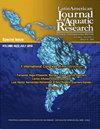Argopecten purpuratus(软体动物,果蝇科)Post-El Nino 1997-98 Rinconada海洋保护区(智利安托法加斯塔)的反应
IF 0.8
4区 农林科学
Q3 FISHERIES
Latin American Journal of Aquatic Research
Pub Date : 2022-05-01
DOI:10.3856/vol50-issue2-fulltext-2776
引用次数: 2
摘要
从1999年到2001年,通过监测幼虫及其随后在人工收集器上的定居情况,直接评估了La Rinconada的斑胸蛛种群,以确定其密度、大小结构和丰度。1999年,标本数量增加,比1997年增加了一倍。然而,分布面积、标本和平均大小的减少发生在2000年和2001年,反映了人为影响。将增长参数应用于年度规模结构表明,1999年至2000年间损失了570万人,2000年至2001年间损失了500万人。标本增加了90毫米,从1997年的130000只增加到2001年的260万只,这解释了发现的大量幼虫的原因,1999年的记录为17667只和21756只;2000年为16100人;2001年分别为34175和21700。幼虫的存在与幼虫后定居之间的关系无法确定;只能观察到幼虫丰度期与最大固定期之间的关系。总之,迫切需要采取补充或替代措施,解决影响保护区的非法捕鱼问题。本文章由计算机程序翻译,如有差异,请以英文原文为准。
Argopecten purpuratus (Mollusca, Pectinidae) post-El Niño 1997-98 response in La Rinconada Marine Reserve (Antofagasta, Chile)
From 1999-2001, the Argopecten purpuratus population at La Rinconada was directly evaluated by monitoring larvae and their subsequent settlement on artificial collectors to determine their density, size structure, and abundance. An increase in specimens, doubling the number observed in 1997, occurred in 1999. However, reductions in the distribution area, specimens, and average size occurred in 2000 and 2001, reflecting anthropogenic impacts. Application of the growth parameters to the annual size structure indicated losses of 5.7 million individuals between 1999 and 2000 and 5 million between 2000 and 2001. The specimens increase over 90 mm, from 130,000 in 1997 to 2.6 million in 2001, explains the high larvae numbers found, with records of 17,667 and 21,756 in 1999; 16,100 in 2000; and 34,175 and 21,700 in 2001. A relationship between larval presence and postlarval settling could not be established; only the relationships between periods of larval abundance and those of maximum fixation could be observed. In conclusion, a viable solution to illegal fishing affecting the reserve with complementary or substitute measures for local fishers is urgently required.
求助全文
通过发布文献求助,成功后即可免费获取论文全文。
去求助
来源期刊

Latin American Journal of Aquatic Research
FISHERIES-MARINE & FRESHWATER BIOLOGY
CiteScore
1.70
自引率
10.00%
发文量
44
审稿时长
4-8 weeks
期刊介绍:
Latin American Journal of Aquatic Research- LAJAR is the continuation of the journal Investigaciones Marinas (1970-2007) and is published since 2008 by the Escuela de Ciencias del Mar, Facultad de Ciencias del Mar y Geografía of the Pontificia Universidad Católica de Valparaíso. LAJAR is an “Open Access” journal that publishes in English language, original research articles, reviews and short communications on aquatic science, which contain the results of research conducted in aquaculture or in oceanic and coastal marine waters of Latin America.
The following topics are considered: Physical Oceanography, Chemical Oceanography, Marine Biogeochemistry, Marine Pollution and Toxicology, Marine Geology and Geophysics, Biological Oceanography, Fisheries and Aquaculture.
 求助内容:
求助内容: 应助结果提醒方式:
应助结果提醒方式:


